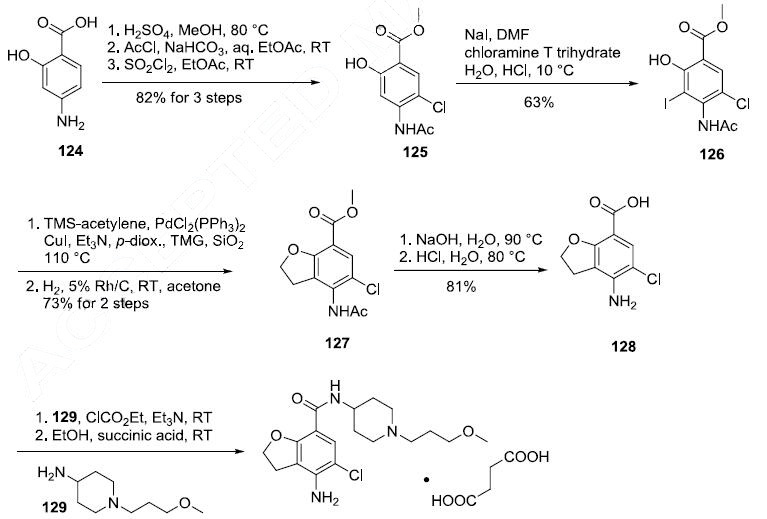|
| | Prucalopride Succinate Basic information |
| Product Name: | Prucalopride Succinate | | Synonyms: | Butanedioic acid 4-amino-5-chloro-2,3-dihydro-N-[1-(3-methoxypropyl)-4-piperidinyl]-7-benzofurancarboxamide;Prucalopride Succinate;Prucalopride Succinate API;PRUCALOPRIDE INTERMEDIATES;Prucalopride Succinat;Prucalopride Succinate WS;Butanedioic acid, compd. with 4-amino-5-chloro-2,3-dihydro-N-[1-(3-methoxypropyl)-4-piperidinyl]-7-benzofurancarboxamide (1:1);Prucalopride Impurity | | CAS: | 179474-85-2 | | MF: | C22H32ClN3O7 | | MW: | 485.96 | | EINECS: | 680-639-5 | | Product Categories: | Inhibitors | | Mol File: | 179474-85-2.mol |  |
| | Prucalopride Succinate Chemical Properties |
| Melting point | >196°C (dec.) | | storage temp. | Sealed in dry,Room Temperature | | solubility | DMSO (Slightly), Methanol (Slightly) | | form | Solid | | color | White to Pale Brown | | InChIKey | QZRSNVSQLGRAID-UHFFFAOYSA-N | | SMILES | C(O)(=O)CCC(O)=O.O1C2=C(C(NC3CCN(CCCOC)CC3)=O)C=C(Cl)C(N)=C2CC1 |
| | Prucalopride Succinate Usage And Synthesis |
| Chemical Properties | Butanedioic acid 4-amino-5-chloro-2,3-dihydro-N-[1-(3-methoxypropyl)-4-piperidinyl]-7-benzofurancarboxamide is Off-White to Pale Brown Solid
| | Uses | Butanedioic acid 4-amino-5-chloro-2,3-dihydro-N-[1-(3-methoxypropyl)-4-piperidinyl]-7-benzofurancarboxamide is a selective 5-HT4 receptor agonist used effective for chronic constipation, but is not currently approved in the U.S. Prucalopride is approved for the treatment of chronic constipation in Europe.
| | Uses | Prucalopride is a selective 5-HT4 receptor agonist used effective for chronic constipation, but is not currently approved in the U.S. Prucalopride is approved for the treatment of chronic constipation in Europe. | | Clinical Use | Prucalopride succinate, a first-in-class dihydrobenzofurancarboxamide, is a selective serotonin (5-
HT4) receptor agonist. The drug, marketed under the brand name Resolor®, possesses
enterokinetic activity and was developed by the Belgian-based pharmaceutical firm Movetis.
Prucalopride alters colonic motility patterns via serotonin 5-HT4 receptor stimulation, triggering the
central propulsive force for defecation. | | Synthesis | The preparation of prucalopride succinate begins with
the commercially available salicylic aniline 124. Acidic esterification, acetylation of the
aniline nitrogen atom, and ambient-temperature chlorination via sulfuryl chloride (SO2Cl2) converted
aminophenol 124 to acetamidoester 125 in 83% yield over the course of three steps. An
unique set of conditions involving sodium tosylchloramide (chloramine T) trihydrate and sodium iodide were then employed to convert 125 to o-phenolic iodide 126, which then underwent sequential
Sonogashira/cyclization reaction utilizing TMS-acetylene with tetramethylguanidine (TMG) in the
presence of silica gel to furnish the benzofuran progenitor of 127. Hydrogenation of this
intermediate benzofuranyl Sonagashira product saturated the 2,3-benzofuranyl bond while leaving the
chlorine atom intact, ultimately delivering dihydrobenzofuran 127 in excellent yield for the two step
sequence. Base-induced saponification and acetamide removal gave rise to acid 128. This acid was
activated as the corresponding mixed anhydride and treated with commercial piperidine 129 to construct
prucalopride which was stirred at room temperature for 24 hours in ethanolic succinic acid to provide
prucalopride succinate (XI). The yield for the formation of the salt was not provided. 
|
| | Prucalopride Succinate Preparation Products And Raw materials |
|